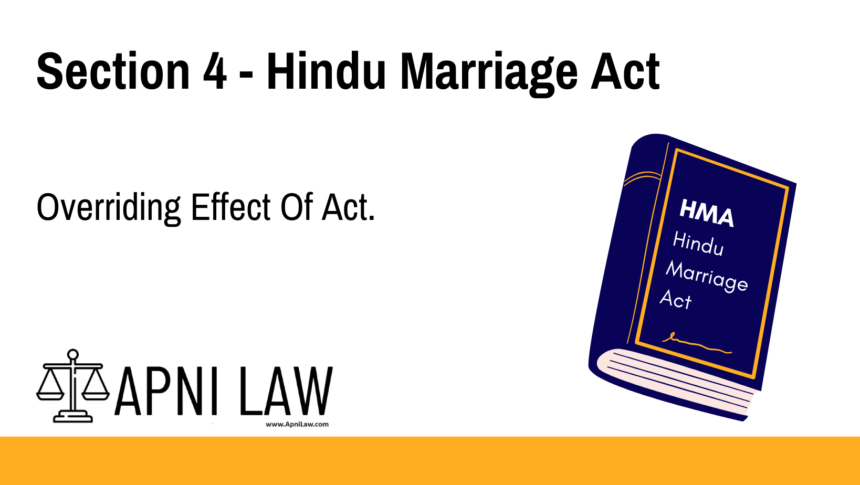Code: Section 4 of the Hindu Marriage Act, 1955
“Overriding effect of Act.—Save as otherwise expressly provided in this Act,—
(a) any text rule or interpretation of Hindu law or any custom or usage as part of that law in force immediately before the commencement of this Act shall cease to have effect with respect to any matter for which provision is made in this Act;
(b) any other law in force immediately before the commencement of this Act shall cease to have effect in so far as it is inconsistent with any of the provisions contained in this Act.”
⎯
Explanation of Section 4 – What Does “Overriding Effect” Mean?
Section 4 gives the Hindu Marriage Act, 1955, legal supremacy over older customs, religious laws, or inconsistent laws that existed before this Act came into force.
This means:
- If a Hindu custom or tradition contradicts the Hindu Marriage Act, it no longer applies.
- If any other law (central, state, or religious) conflicts with the Hindu Marriage Act, the Act will override it.
- The Act aims to modernize Hindu marriage law by replacing inconsistent or outdated rules.
Section 4 ensures a uniform legal framework by eliminating conflicting traditional practices and legal uncertainties.
⎯
Why Is Section 4 Important?
Before 1955, Hindu marriage laws were mostly based on religious texts and local customs. These varied across regions and communities. Section 4 helps bring clarity and uniformity.
It protects individuals—especially women—from discriminatory practices that were once justified using customs or older religious interpretations.
It also ensures that courts enforce only what the Hindu Marriage Act provides, instead of relying on pre-existing, conflicting norms.
⎯
Illustration: Examples of Overriding Effect
Example 1: Custom Conflicting with Age of Marriage
A traditional community allows girls to marry before 18. The Hindu Marriage Act sets the legal minimum age as 18 for women. Under Section 4, this custom has no legal effect.
Example 2: Rule on Bigamy
Before 1955, some Hindu communities allowed polygamy. The Hindu Marriage Act prohibits it. So, despite the earlier custom, a second marriage during the lifetime of a spouse is now void and punishable.
Example 3: Property and Maintenance
If an older law or custom prevents a wife from claiming maintenance after separation, Section 4 ensures she still has that right under the Act.
⎯
Common Questions and Answers on Section 4 – Overriding Effect
Q1: Does Section 4 cancel all Hindu customs?
A: No. Only those customs that are inconsistent with the provisions of the Hindu Marriage Act are overridden. If a custom is not in conflict with the Act, it may still apply.
Q2: Can a religious text override this law?
A: No. Section 4 makes it clear that no rule, religious interpretation, or text can contradict the Act where the Act has made specific provisions.
Q3: What happens if another law conflicts with the Hindu Marriage Act?
A: That part of the law will cease to apply, to the extent of the conflict. The Hindu Marriage Act will prevail.
Q4: Does this Section protect women’s rights?
A: Yes. It ensures that outdated or unfair customs, like child marriage or polygamy, cannot override the legal rights provided by the Act.
⎯
Conclusion
Section 4 of the Hindu Marriage Act, 1955, plays a crucial role in establishing the authority of this Act over previous Hindu laws, customs, and other laws. It provides legal clarity and ensures that all Hindus are governed by a consistent and modern framework in marriage-related matters. By eliminating outdated customs, it promotes equality, fairness, and justice within Hindu personal law.
For more insights into Hindu family law and legal reforms, visit ApniLaw.








